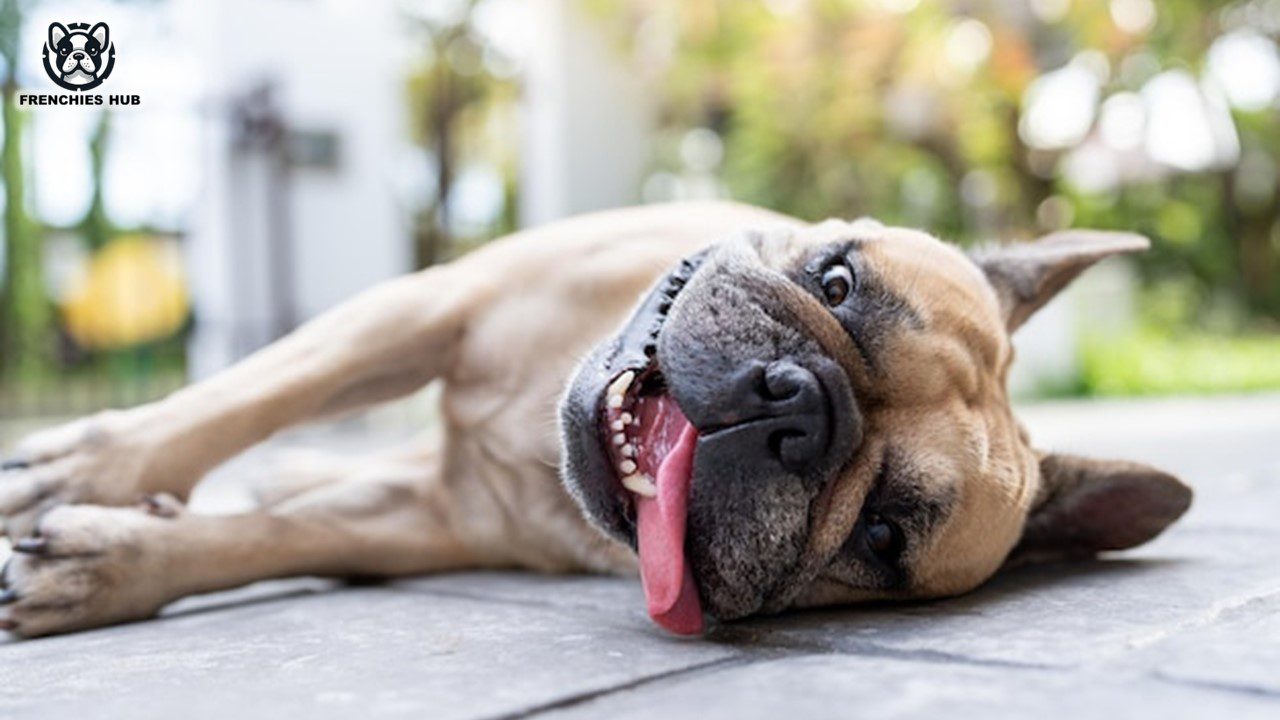As a French Bulldog owner, understanding the risk of heat stroke is crucial. These lovable dogs, with their shorter breathing system, are particularly vulnerable to heat exhaustion. Their shorter airway limits the cooling of the air they breathe in, making them prime victims of heat-related issues. Unlike humans, dogs don’t sweat; their primary way of reducing built-up body heat is through panting. This makes it essential for us to be vigilant and proactive in protecting our pets.
One of the leading causes of heat exhaustion in dogs, particularly French Bulldogs, is leaving them in a hot car. Even on a mild day, the temperature inside a car can raise to 130 degrees quickly. A slightly open window is insufficient to prevent heat build-up. Never leave your dog in a car, as it poses a severe risk to their life. The rapid advancing from heat exhaustion to heat stroke can be fatal.
Several variables can trigger heat exhaustion in a dog. These include the dog’s physical condition, age, coat length, breed, and acclimatization to heat. An older, couch-potato dog with low tolerance to heat will be more vulnerable compared to a young, romp-loving adolescent who spends time outside. Both the very young and the very old are in the highest risk categories. Regardless of their condition, all Frenchies are at risk. It’s vital to recognize these variables and ensure that your French Bulldog can breathe comfortably and stay active without overheating.
Common Situations Leading to Heat Stroke in French Bulldogs
Heat stroke in French Bulldogs is a serious risk, and as an owner, it’s essential to be aware of the common situations that can lead to this dangerous condition. Leaving your dog in a car during hot weather is one of the primary culprits. Even a short duration can turn lethal as temperatures soar inside the vehicle. Exercising strenuously in humid weather also poses a significant threat, especially for brachycephalic breeds like the Bulldog, Pug, and Pekingese. These breeds have unique challenges due to their anatomy, making them more susceptible to difficulty breathing.
Dogs with a history of heart or lung disease are at a higher risk, as their compromised breathing efficiency can quickly exacerbate the effects of heat. Another critical factor is being muzzled while under a hair dryer, which can prevent them from panting effectively. Conditions like a high fever or seizures further complicate the situation.
Surfaces like concrete and asphalt can become dangerously hot, increasing the likelihood of heat-related issues if your dog is confined without shade or fresh water. Recognizing these risk factors and avoiding them can help keep your French Bulldog safe.
Recognizing Symptoms of Heat Stroke in French Bulldogs
Recognizing the symptoms of heat stroke is vital. It typically begins with heavy panting and difficulty breathing. You might notice your dog’s tongue and mucous membranes turning bright red, while the saliva becomes thick and tenacious. Vomiting is common, and the rectal temperature can spike between 104° to 110°F (40° to 43.3°C). As the condition worsens, your dog may become unsteady, passing bloody diarrhea. Shock can set in, turning the lips and mucous membranes gray, leading to collapse, seizures, coma, and ultimately, death.
Identifying and Addressing Heat Exhaustion
Early signs of heat exhaustion include excessive panting and flushed, red skin inside the ears. If not addressed, this can progress to heat stroke, characterized by weakness, staggering, and fainting, leading to a loss of consciousness. This situation is an emergency. You must cool your dog down as rapidly as possible and seek veterinary treatment immediately. Remember, heat stroke is an emergency – treat your dog NOW to ensure their survival.
Key Points:
- Never leave your French Bulldog in a car during hot weather.
- Avoid strenuous exercise in hot, humid conditions.
- Be extra cautious with brachycephalic breeds like Bulldogs, Pugs, and Pekingese.
- Ensure your dog has access to shade and fresh water at all times.
- Recognize the signs of heat stroke early and act quickly to cool your dog down.
Common Situations Leading to Heat Stroke
Heat stroke in French Bulldogs is a serious risk, and as an owner, it’s essential to be aware of the common situations that can lead to this dangerous condition. Leaving your dog in a car during hot weather is one of the primary culprits. Even a short duration can turn lethal as temperatures soar inside the vehicle. Exercising strenuously in humid weather also poses a significant threat, especially for brachycephalic breeds like the Bulldog, Pug, and Pekingese. These breeds have unique challenges due to their anatomy, making them more susceptible to difficulty breathing.
Dogs with a history of heart or lung disease are at a higher risk, as their compromised breathing efficiency can quickly exacerbate the effects of heat. Another critical factor is being muzzled while under a hair dryer, which can prevent them from panting effectively. Conditions like a high fever or seizures further complicate the situation.
Surfaces like concrete and asphalt can become dangerously hot, increasing the likelihood of heat-related issues if your dog is confined without shade or fresh water. Recognizing these risk factors and avoiding them can help keep your French Bulldog safe.
Treatment of Heat Stroke in French Bulldogs
When dealing with heat stroke in your French Bulldog, it’s crucial to act swiftly and correctly. Emergency measures to cool your dog should begin immediately. Move your dog out of the source of heat, ideally into an air-conditioned building. Regularly check their rectal temperature every 10 minutes. Mild cases might resolve simply by moving your dog to a cool environment.
For more severe cases, begin rapid cooling by spraying your dog with a hose or immersing them in a tub of cool water (not ice water) for up to two minutes. Using an electric fan to blow on the wet dog can also help. Applying cool packs to the groin area and wiping their paws with cool water are effective methods too. Continuously monitor the rectal temperature and stop the cooling process once it falls below 103°F (39°C). Overcooling can lead to hypothermia and shock.
During this process, do not try to force your dog to drink. Swelling airways can cause any liquid they take in to be regurgitated and possibly aspirated into their lungs. Instead, focus on external cooling. Hose your dog down with cool water – not cold. Apply an ice pack to their head and use soaked towels or other forms of fabric on their body. If possible, get your dog into a tub of cool water. In an extreme emergency, if cold water is the only option, use it cautiously.
If these methods are not working, a cool water enema can help to cool your dog internally. Be careful not to induce cooling too rapidly or with water that is too cold, as this can cause serious shock. As your dog is panting, their airways may be swelling, causing them to pant even harder. Breaking this cycle is critical. Children’s allergy treatment Benadryl can be administered orally using a dropper. Always consult your vet for the exact dosage and, if possible, keep a supply of injectible Benadryl on hand.
Do not stop the treatment until your dog’s body temperature approaches normal. Once their internal temperature has stabilized, transport them to your vet immediately. Heat stroke can leave permanent damage, so professional veterinary care is essential.
Many dogs will play until they drop, so you must supervise their games. During hot weather, limit your dog’s time outside. Ensure there is a shaded area for your dog to rest and a constant supply of clean water. Never underestimate your dog’s susceptibility to heat stroke. Limit their exposure to temperatures you might find only mildly hot. Be conscious of your dog’s proximity to hot pavement and never leave your Frenchie in a locked car in even warm weather. Always provide plenty of access to fresh water, shade, and cool areas. Be alert and prepared with the necessary items to save your dog’s life.
Dehydration in French Bulldogs
Dehydration in French Bulldogs can occur when they lose body fluids faster than they can replace them. This loss usually involves both water and electrolytes. Common causes of dehydration in dogs include severe vomiting, diarrhea, and inadequate fluid intake, often associated with fever and severe illness. A rapid loss of fluids also occurs with heat stroke.
A prominent sign of dehydration is a loss of skin elasticity. When the skin along the back is pulled up, it should spring back into place, but in a dehydrated dog, the skin stays up in a ridge. Other signs include dryness of the mouth, where the gums, which should be wet and glistening, become dry and tacky. The saliva becomes thick and tenacious. In an advanced case, the eyes may appear sunken, and the dog may show signs of shock, including collapse.
Treatment of Dehydration in French Bulldogs
A dog showing signs of dehydration requires immediate veterinary attention. Treatment often involves intravenous fluids to replace lost fluids and prevent further loss. For mild dehydration, if the dog is not vomiting, you can give an electrolyte solution using a bottle or syringe into the cheek pouch. Balanced electrolyte solutions for treating dehydration in children, such as Ringer’s lactate with 5 percent dextrose in water or Pedialyte solution, are available at drugstores and are also suitable for dogs. Gatorade can be a short-term substitute to help replace fluids. Administer the solution at a rate of 2 to 4 ml per pound (1 to 2 ml per kilo) of body weight per hour, depending on the severity of the dehydration, or as directed by your veterinarian.
Summer Safety Checklist for French Bulldogs and Other Brachycephalic Breeds
- Always have children’s liquid Benadryl on hand for emergencies.
- Carry bottled water to keep your dog hydrated.
- Keep a clean enema bag and clean towels that you can soak in water for quick cooling.
- Invest in cooling pads and cool coats to maintain a comfortable body temperature.
- Use a portable battery-operated fan for immediate relief from the heat.
- Ensure your dog has access to shade at all times.
- Keep your closest emergency vet’s phone number and address readily available.
- Always provide access to a cool shaded area and NEVER leave your dog in a car, even if the weather is only warm.
- Remember, Frenchies can overheat in an instant, so be vigilant and proactive in their care.

